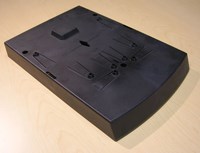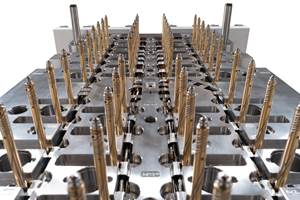DFMA Software: Opportunities in Disguise
Design for manufacture and assembly software enables better communication between manufacturers and design teams, so problem-solving relationships are developed and successful products are created.
Design for manufacture and assembly (DFMA) is a term often used, but its true meaning and value may have been lost. DFMA is a set of core values combined with a systematic approach for reducing design complexity and cost. These core values include optimizing all areas of the manufacturing process: fabrication, assembly, test, procurement, shipping, delivery, service and repair.
The focus is specifically on ensuring optimal balance between cost, quality, reliability, safety, time-to-market and customer satisfaction.1 The best way to take advantage of this approach is to apply it early in the design process using a DFMA software tool (see Figure 1).
DFMA software tools provide a clean and consistent method for applying the principles of DFMA at anytime throughout the development process. Even at the early stages of design, when only rough geometries are present, engineers can use the software to obtain valuable data.2 This software gives the design team the ability to evaluate alternate materials and manufacturing processes early on by providing piece part costs as well as tooling costs. Even the smallest design change can be evaluated, allowing for the cost drivers for each part/assembly to be easily identified. Having this wealth of information allows for faster, more informed decision making at all levels, shortening the development cycle.
In addition to piece part and tooling costs, these software tools provide a quantifiable way to identify unnecessary parts and determine assembly times and costs.3 This information allows the design team to construct the most efficient, cost-effective design possible. Also, the costing values generated by the software are based upon real-world information, allowing them to be used as a vendor negotiating tool. With the ’should-cost’ values in-hand, the development team can evaluate vendor quotes based on detailed information about cycle times, machine size, mold cost, etc.3
Design teams and product development firms have been using this approach to foster success for quite some time. Datum3D, a Boston area product development consultancy, uses DFMA as their core principles throughout the design process. One of their projects, pictured in Figure 2, benefited particularly well from these values and the use of DFMA software.
The project was a complete redesign of a wafer handling system. This part, just a small piece of the complete effort, succeeded in combining 25 parts into one and reducing cost by approximately 50 percent. DFMA software was used throughout the design effort to evaluate the cost/benefit of alternate materials and design features. Ultimately, the project proved to be a complete success for Datum3D and their client.
As shown in Figure 2, product development teams can benefit greatly from the use of DFMA software. However, what about vendors and suppliers? At first, some vendors may view software tools like this as an annoyance or even a competitor. However, if examined more closely, it can be seen that DFMA software adds value for the vendor as well. Moldmakers and injection molders can benefit from their clients using the software, but also by using it themselves.
Moldmakers can use the software as a self-benchmarking tool, and a means of evaluating their own quoting process and methods. By running the software in parallel to their own quoting process, molders will be able to identify any possible discrepancies and address them up front. Additionally, the software will provide a means for directly identifying the cost drivers associated with each step of their process. This will allow them to optimize their machine setups and processes and provide their potential clients with the most competitive quote possible.
Using the software, moldmakers will also be able to identify the cost drivers associated with each element of their client’s design. This will give them a distinct advantage during negotiations with the client. With quantifiable data to backup the quotes, moldmakers will be able to justify each cost associated with every aspect of the project. They can also bring this information to the client through thoughtful suggestions on ways to cut costs associated with the manufacturing. Bringing these cost saving ideas to the table will immediately impress upon the client a commitment to them and their product. Then, using the suggestions, the moldmaker can work with their client to effect the changes and reduce cost. These collaborative design improvements will foster a next level relationship between the moldmaker and their client.
Summary
The principles behind DFMA and the use of specific DFMA software tools can contribute greatly to a project’s success. With the focus on optimizing the balance between cost, quality and customer satisfaction, DFMA offers a solid approach to design and development of any new product. The software tools must provide the means with which to apply these principles for both design teams and their suppliers. Even moldmakers can reap the benefits from using these tools. By creating a level platform as the basis for communication between manufacturers and design teams, problem solving relationships are developed and successful products are the outcome.
1 Anderson, Dr. David M. “Design for Manufacturability & Concurrent Engineering.” CIM Press, 2008.
2 www.dfma.com/software/dfm.htm February 11, 2010.
3 www.dfma.com/software/dfm.htm February 11, 2010.
Related Content
Confronting the Mold Design Talent Drought
Recently, I reposted on LinkedIn the results of an informal survey we conducted, which revealed a shortage of skilled mold designers. It quickly gained a lot of traction. Given the response, I thought I'd summarize the feedback and keep the conversation going.
Read MoreHow to Solve Hot Runner Challenges When Molding with Bioresins
A review of the considerations and adaptations required to design hot runners and implement highly productive injection molding operations.
Read MoreThe Role of Social Media in Manufacturing
Charles Daniels CFO of Wepco Plastics shares insights on the role of social media in manufacturing, how to improve the “business” side of a small mold shop and continually developing culture.
Read MoreMaking Quick and Easy Kaizen Work for Your Shop
Within each person is unlimited creative potential to improve shop operations.
Read MoreRead Next
Are You a Moldmaker Considering 3D Printing? Consider the 3D Printing Workshop at NPE2024
Presentations will cover 3D printing for mold tooling, material innovation, product development, bridge production and full-scale, high-volume additive manufacturing.
Read MoreReasons to Use Fiber Lasers for Mold Cleaning
Fiber lasers offer a simplicity, speed, control and portability, minimizing mold cleaning risks.
Read MoreHow to Use Continuing Education to Remain Competitive in Moldmaking
Continued training helps moldmakers make tooling decisions and properly use the latest cutting tool to efficiently machine high-quality molds.
Read More





















